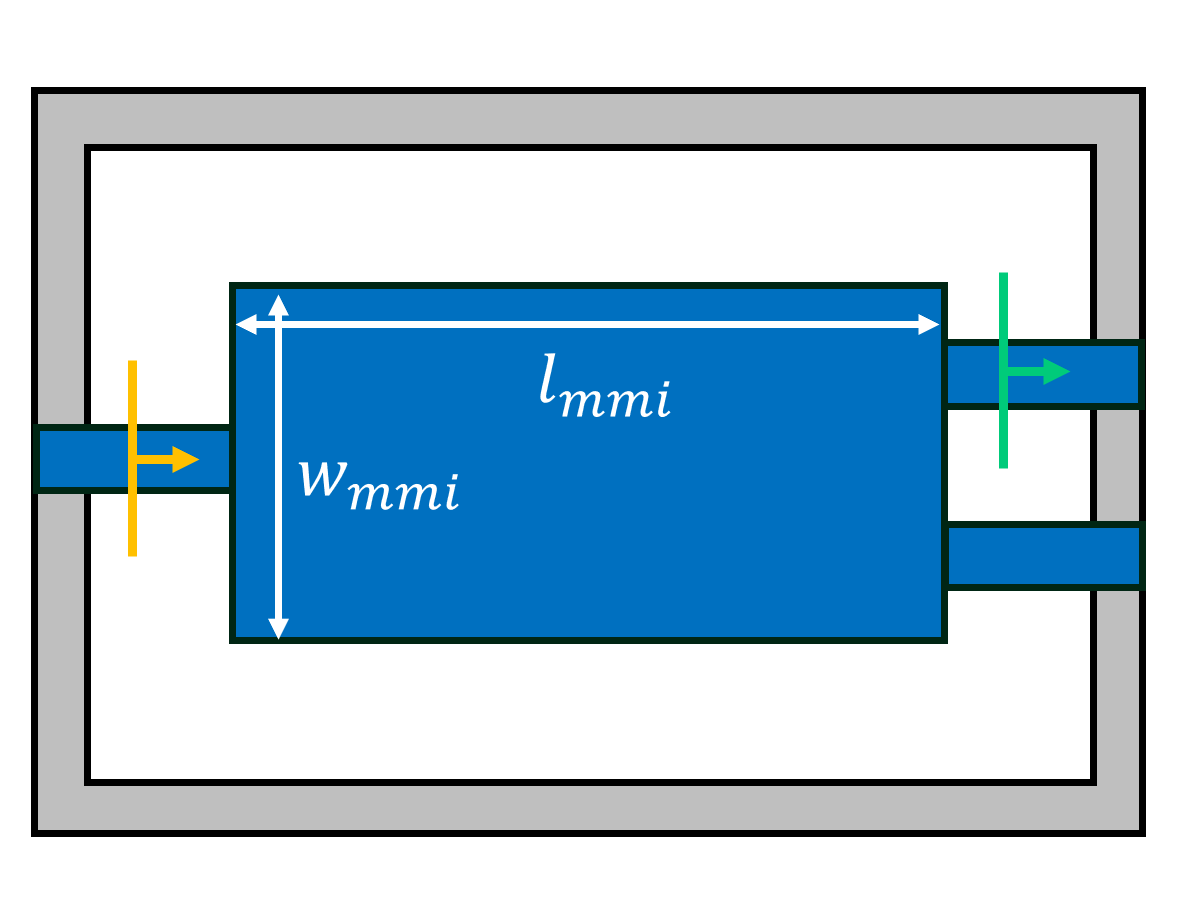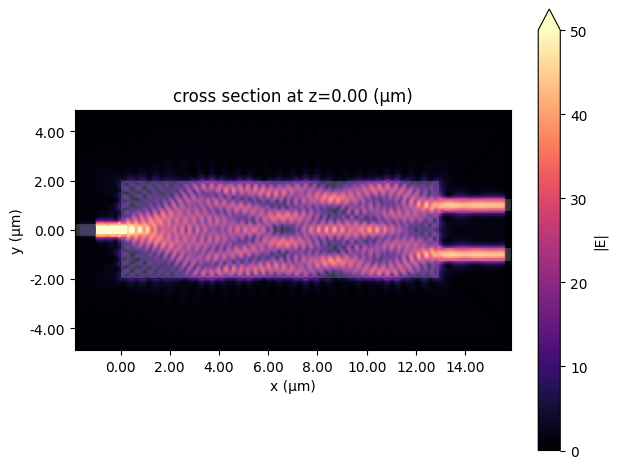Inverse design quickstart - level 2#
This notebook builds upon the previous quickstart notebook by demonstrating a slightly more advanced inverse design optimization using Tidy3D. In this level 2 notebook, we explore inverse design optimization of a multimode interference (MMI) power splitter. Our inverse design goal is to minimize loss by optimizing the width and length of the MMI.
Throughout this notebook, we will set up the simulation, define the objective function clearly, run an optimization loop, and visualize the optimized field distribution, providing insights into the power of inverse design in integrated photonics.

For more advanced inverse design examples and tutorial notebooks, check out
To see all Tidy3D examples and tutorials, as well as other learning materials, please visit our Learning Center.
[1]:
import autograd as ag
import autograd.numpy as anp
import optax
import tidy3d as td
import tidy3d.web as web
Define a function to create a Simulation based on MMI width and length parameters. We set up a ModeSource to excite a guided mode and a ModeMonitor to measure transmission. The width and length
will be combined into an array called param, where the first element is the width and the second element is the length. Here we only have two design parameters but in principle, this array can have an arbitrary number of parameters.
The MMI geometry is created by a PolySlab, which is a polygon defined by the coordinates of the vertices. The vertices of the geometry are denoted by the red dots in the schematic below. We manually define the vertices for the top half of the MMI and add a symmetric copy for the vertices on the bottom half.

[2]:
def make_sim(params: anp.ndarray) -> td.Simulation:
"""Create a Tidy3D simulation given MMI width and length parameters."""
width_mmi = params[0]
length_mmi = params[1]
# add a mode source located at the simulation entrance to excite the guided mode
source = td.ModeSource(
center=[-1, 0, 0],
size=[0, 1.5, 1.5],
source_time=td.GaussianPulse(freq0=td.C_0 / 1.55, fwidth=0.1 * td.C_0 / 1.55),
mode_spec=td.ModeSpec(),
direction="+",
)
# add a mode monitor located at the simulation exit to measure transmitted mode amplitude
mode_monitor = td.ModeMonitor(
name="mode",
center=[15, 1, 0],
size=[0, 1.5, 1.5],
freqs=[td.C_0 / 1.55],
mode_spec=td.ModeSpec(),
)
# add a field monitor to measure the field distribution
field_monitor = td.FieldMonitor(
name="field",
size=[td.inf, td.inf, 0],
freqs=[td.C_0 / 1.55],
)
# define the vertices for the MMI structure geometry
top_vertices = [
(-10, 0.25),
(0, 0.25),
(0, width_mmi / 2),
(length_mmi, width_mmi / 2),
(length_mmi, 1.25),
(length_mmi + 10, 1.25),
(length_mmi + 10, 0.75),
(length_mmi, 0.75),
]
# create the MMI structure using the defined vertices
mmi = td.Structure(
geometry=td.PolySlab(
vertices=top_vertices + [(x, -y) for x, y in reversed(top_vertices)],
axis=2,
slab_bounds=(-0.11, 0.11),
),
medium=td.Medium(permittivity=12),
)
# create the simulation
sim = td.Simulation(
center=[7, 0, 0],
size=[17, 8, 3],
symmetry=[0, -1, 1],
grid_spec=td.GridSpec.auto(min_steps_per_wvl=15),
run_time=8e-12,
medium=td.Medium(permittivity=2),
sources=[source],
monitors=[mode_monitor, field_monitor],
structures=[mmi],
)
return sim
Define Objective Function#
Define the objective function that calculates transmission based on the MMI structure parameters.
[ ]:
def objective_fn(params: anp.ndarray) -> float:
"""Compute the objective function, the squared magnitude of the mode amplitude (transmission power) in the forward direction."""
# run the simulation
sim_data = web.run(simulation=make_sim(params), task_name="adjoint", verbose=False)
return (
anp.abs(sim_data["mode"].amps.sel(direction="+").values.item()) ** 2
) # calculate the transmission power
Optimization Loop#
Next, we use autograd to construct a function that returns the gradient of our objective function and use this to run our gradient-based optimization in a for loop. Instead of the plain gradient descent, here we use the more robust adam optimizer from the open-source library optax.
[4]:
# use autograd to get a function that returns the objective function and its gradient
val_grad = ag.value_and_grad(objective_fn)
# initial design parameters are 4 μm width and 13 μm length
params = anp.array([4.0, 13.0])
# initialize adam optimizer with starting parameters
optimizer = optax.adam(learning_rate=0.01)
opt_state = optimizer.init(params)
for i in range(7):
# compute gradient and current objective function value
value, gradient = val_grad(params)
# compute and apply updates to the optimizer based on gradient
updates, opt_state = optimizer.update(-gradient, opt_state, params)
params[:] = optax.apply_updates(params, updates)
print(f"step = {i + 1}")
print(f"\ttransmission = {1e2 * value:.1f}%")
step = 1
transmission = 28.5%
step = 2
transmission = 37.8%
step = 3
transmission = 41.7%
step = 4
transmission = 43.0%
step = 5
transmission = 43.6%
step = 6
transmission = 43.9%
step = 7
transmission = 43.8%
Analysis#
During the optimization, we can see that the transmission is significantly increased. The final transmission is close to 44%, over 15% higher than the initial design. Finally, we run a simulation using the optimized parameters and visualize the resulting electric field distribution, which shows nice power splitting.
[5]:
data_final = web.run(simulation=make_sim(params), task_name="optimized_mmi", verbose=False)
data_final.plot_field("field", "E", "abs", vmin=0, vmax=50);
